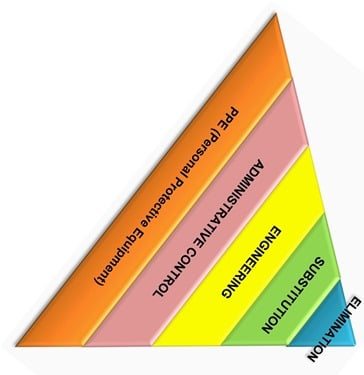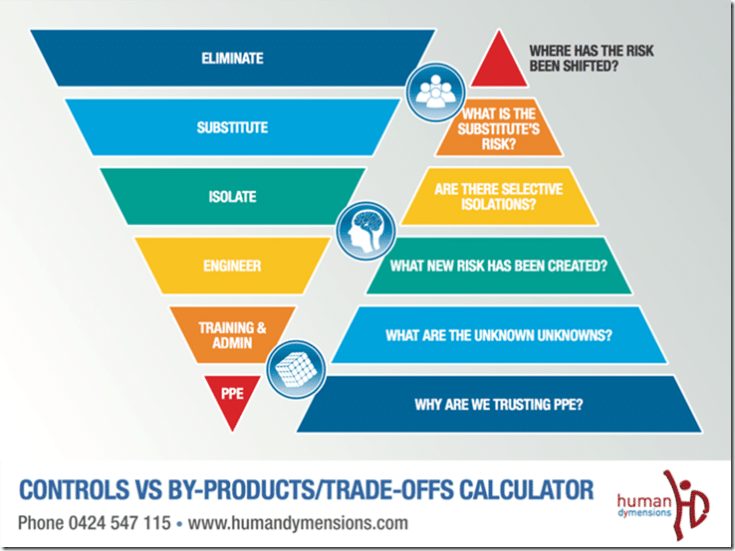Why Is The Hierarchy Of Control So Ineffective
Time to commit ‘Safety Sacrilege’! Where would Safety be without it’s Sexy Curves and Pyramids?
See also: Risk and Safety Matrices and the Psychology of Colour
For most, safety is about controlling hazards and the tool of choice is the Hierarchy of Control (HOC). It is enshrined in safety legislation, traditional textbooks, inductions, training courses and recommended by government authorities as THE method of eliminating or mitigating hazards and risk. Hazard controls are simplistically ranked from most effective and reliable to the least effective and unreliable. If things then go wrong again, the premise is that you should have ‘done better’ and so one must then return to the hierarchy, be smarter and choose a higher order control. Others have proposed alternatives such as Haddon’s Countermeasures which proposes ten strategies (twice as many boxes to tick) for reducing and avoiding damages based on a model of potential harmful energy transfer. But this may be a little complicated and mechanistic to be generally well understood or accepted. See this article by the late George Robotham: Alternatives to The Hierarchy of Control.
This article was inspired by a statement I read recently on where else but LinkedIn. It was to the effect of: “We must take every opportunity to educate the workers on how to use the HOC as PPE seems to be their first and only hazard control choice”. Well, I’m sorry ‘Safety’ this not because they are uneducated but rather because of what you have done to them. YES, THIS IS YOUR FAULT!!!
‘Safety’, in general, has little appreciation of the power of semiotics and unconscious communication. What is the first ‘safety thing’ we see when we enter a workplace or construction site? Mandatory PPE Signs! When we visit virtually any workplace these days, there is very little real discussion about risk but rather, following a ‘tick n flick’ induction, we are issued with a range of PPE which allows us to safely go anywhere, oblivious to the actual risk. When people do satire or make jokes about Safety they are usually fully adorned in PPE. Even the original HOC pyramids showed PPE as the large foundation block, although there have been recent attempts to turn that upside down. I have been in workplaces where considering or initiating controls any higher up the hierarchy than PPE is the dominion of the ‘Safety Expert’ as only they have this knowledge, power and authority to approve. So, we have pretty much framed and primed default safety as PPE! (see You Spell the Devil L-T-I and God P-P-E)
The HOC just doesn’t gel with how people really think, learn and make decisions. It forces linear and simplistic thinking and doesn’t recognise the multitude of reasons we make decisions about hazards and risk, mostly unconsciously ie financial constraints, hubris, heuristics, bias, satisfycing, knowledge, experience, fear, hindsight, complacency, social culture, defensive decision making, bounded rationality etc etc etc etc. People already unconsciously know that elimination may be the best solution (Well it isn’t always but that is a whole other subject – see Risk Homeostasis or The 5 B’s Of Safety Conversion or The Banned Objects Index if interested) but there are all those unconscious and realistic reasons above why they choose lower order controls that make sense to them. Forcing this type of thinking, I believe, is a waste of time. Teaching and relying on the HOC as “THE method” may unwittingly be saying to people that PPE is always a very acceptable control as its cheap, easy and on the list? See the Control Vs By-products/Trade Off Calculator by HumanDymensions below:
Another issue which makes it ineffective is that the HOC does not encourage thinking about the possible ramifications, risk transfer or unintended by-products of the chosen control. For example, when we simply close a dangerous road we can tick off the elimination box but where does all that traffic go? When we substitute a safer chemical do people then use twice as much to ensure continued effectiveness. What about training and ongoing maintenance for new engineering controls. Risk homeostasis theory tells us that making things safer may simply encourage people to take more or different risks.
The HOC only encourages us to think about and control individual hazards and we should know that risk management is much more complex than that. As well as not addressing how individuals make decisions (headspace), nor does it encouraging thinking about that hazard in the context of the whole workspace or groupspace (culture). So, once we’ve achieved some sort of control over a single hazard, then we address the next, then the next, then back to the first to address the unintended by-products of the first control on the down stream process and other teams, then the next etc etc. This is an endless loop which is fed by an endless supply of these hazards every day – more controls, more procedures, more confusion, more unintended by-products, more to go wrong, more injury, more blame……….
Dr Rob Long, in “When The Tool Becomes the Method”, says that:
All tools require a method of use, whether a hammer, telescope or statistic. Every method also ‘hides’ a methodology that is, the ideological design behind the purpose and meaning of the tool itself. Ellul (The Technological Society) called this ideological design ‘technique’ meaning, the values and ideology embedded in technology. This is why sometimes people wonder whether a person is controlling an iPhone or whether the iPhone controls them.
Once tools (and methods) have been institutionalized, they are rarely questioned, interrogated or subject to scrutiny and, when they are questioned, it is the scrutineer that is often made problematic, not the question. This is the case with many defective tools that have crept into the safety industry that we are unlikely to ever have the courage to erase.
So, what is a more effective method than the mechanistic and simplistic HOC?
For erasing any defective safety tool, Rob Long recommends:
“The only way to really escape the trap of the tool as the method is to take up more qualitative activities in safety work. It is such activities as walks, learning, listening, dialogue, considering uncertainties, conversations and critical thinking that are of much greater value to the development of a safer organisation.”
My personal favourite open questions to ask when considering hazard controls and to avoid using the HOC are:
-
Walk me through the process or what you are doing?
-
What are some of the things that might go wrong and what do you/can you do about them?
-
What are some better ways (I don’t say safer ways) of doing this?
-
What affect might those different ways have on the risk to other people or other steps in the process?
To end, the question I would like people to think about (and answer here if you are brave) was inspired by Rob Sams, who made this comment on the previously mentioned LinkedIn article: “I’m not sure that a simple linear ‘solution’ focused approach (e.g. The hierarchy) is well matched to complex challenges (like risk). Do you think that the Hierarchy of Controls might be the outcome of a too simplistic approach to dealing with risk?”
You may also like:
The 5 Ways We Identify Hazards
 The 5 Ways We Identify Hazards – Updated Hazards are objects and in themselves don’t harm anyone. An object only becomes a hazard when a human engages with it, until then it remains a potential hazard. One can focus as much on displacement of energies and damaging energies as one wants but unless there is some …… Enjoy the rest of the article >>>>>
The 5 Ways We Identify Hazards – Updated Hazards are objects and in themselves don’t harm anyone. An object only becomes a hazard when a human engages with it, until then it remains a potential hazard. One can focus as much on displacement of energies and damaging energies as one wants but unless there is some …… Enjoy the rest of the article >>>>>




Do you have any thoughts? Please share them below